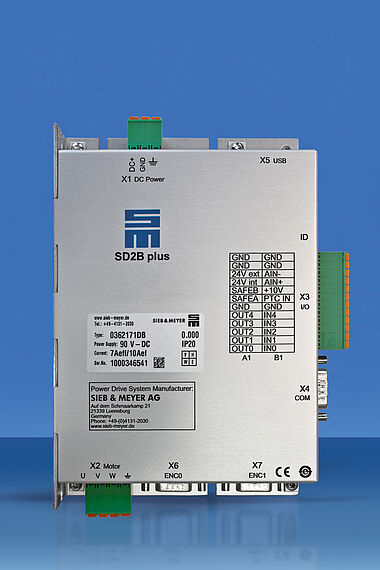Frequency Converters in Polygon Scanners: Precise Driving of Sorting Machines
Technical papers
SD2B plus enables flexible control
If several polygon scanners work together, as for example in sorting machines, these scanners must be synchronized. For this purpose, the systems developed by KUGLER GmbH are equipped with frequency converters of the series SD2B plus by SIEB & MEYER – in combination with encoders. The latter are not required in systems with single polygon scanners because the frequency converter SD2B plus controls these even without encoders. Flexible system configuration with only one frequency converter is a great advantage not only for KUGLER but also for the end customers.
In 1983, Lothar Kugler constructed the first interferometer for non-contact flatness measurement in Salem at Lake Constance (Germany). This innovation led to a thriving enterprise because the interest in the market was high. Today, KUGLER GmbH builds precision machines that rate among the best of the world. Another business area is high-performance laser optics: KUGLER develops and manufactures reflective optics and optical system components for the laser industry that are required in plant engineering or in lasers for industrial applications. "Some of our products range between optics and mechanical engineering." says Dr. Michael Lehndorff, research and development at KUGLER GmbH. "These products include the polygon scanners."
Sorting food with polygon scanners
Polygon scanners are based on special optics known as polygon mirrors. These are used to redirect laser beams, among other things. Polygons can be mounted on rotary motors to make optics flexible. The angle of the reflected beam depends on the positions of the facets and varies with rotation. "Polygon scanners are used in many fields of applications, from bar code scanners to lasers for eye surgery," Dr. Michael Lehndorff explains. "A more recent development is that we also supply manufacturers of sorting machines." The machines of these customers sort mainly food, for example sweets. Thereby, the goods to be sorted fall down like a curtain at a width of typically one meter. By means of the polygon scanner, the laser can optically capture the parts and classify them. In the next step, the goods are blown into the right channel and conveyed for further processing.
Wanted: complete package including synchronization
With the new clientele, KUGLER had to rethink the control of the polygon scanners. Up to then, most customers of the optics experts had systems using single scanners. Sorting machines require several scanners, though, and these must work synchronously. "The manufacturers wished for a complete package including a low-priced but precise control – and that in larger product quantities," Dr. Michael Lehndorff explains. That was another new challenge for KUGLER – with the polygon scanners produced in series until then, the customers usually took care of the controls and drive systems
KUGLER's supplier for control systems so far could not provide a suitable device. "Fortunately, we had the idea to ask SIEB & MEYER," Dr. Michael Lehndorff remembers. "For several years now, they provide us with the frequency converters for our own machines, which operate tool spindles for example." It turned out that SIEB & MEYER's portfolio included a suitable frequency converter for the purpose: SD2B, which is available as 'plus' variant with additional features since 2017.
Synchronizing several scanners with SD2B plus
One of these features – the sensor control based on TTL encoders – enables the synchronization of several scanners and is therefore a great advantage for KUGLER. "Each scanner has an encoder that is evaluated by SD2B plus," says Dr. Michael Lehndorff. "This makes a precise control of the speed and the positions of the facets possible." For Lehndorff the integrated functions of SD2B plus are additional 'plus factors'. These include the ballast resistor and the internal logic supply – other manufacturers charge extra for these functions or even worse, external solutions are necessary. Last but not least, SD2B plus is a very compact device and requires minimum space, which means profound added value for many end customers.
Precision, even without a sensor
The experts at KUGLER were particularly impressed by the fact that applications with a single scanner can be implemented without speed sensor, since SD2B plus also provides a sensorless control. "If scanners are required to run very smoothly, we had to include an encoder before," says Dr. Michael Lehndorff. "With SD2B plus we can do without the encoders and still get a signal stability in the range of a few nanoseconds." This exceptional precision is reached when SD2B plus receives the synchronization signal from a so-called facet detector. That means, an additional laser beam hits the polygon outside the working area. Whenever a facet passes, the laser signal is reflected to the detector and triggers a pulse. A customer of KUGLER uses this principle very successfully. It makes the operation much more precise than a system with encoder
In general, the polygon scanners by KUGLER are customized for the individual requirements – this applies also and especially to customers using single scanners. The frequency converter, in turn, must be able to adapt flexibly to changing electrical conditions. "In the past, we actually had to make changes by hand and rearrange resistors and capacitors," Dr. Michael Lehndorff remembers. "Today, we can do this quickly and easily digitally. The software drivemaster2 by SIEB & MEYER supports us here quite well." Speaking of support: KUGLER is also very satisfied with the SIEB & MEYER service – especially with the direct contact to the development team. For this reason, the company has recently switched completely to the frequency converters by SIEB & MEYER – by now the existing customers also receive only polygon scanners equipped with SD2B plus from Lüneburg. This way, not only the manufacturers of sorting machines benefit from the combined competence, which will surely spread further: Who knows, which other industries KUGLER's polygon scanners will conquere in the future.